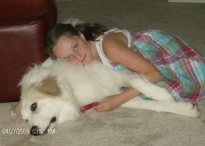Dog Language
Dogs may not speak our language, but dog language is rich, expressive and varied in the ways in which they communicate what they are feeling. They express some of the same basic emotions as humans fear, anger, joy and disgust. Remarkably, dog’s facial expression are very similar to humans and can change in a second. Their faces and bodies have an elaborate and sophisticated composition of nonverbal communication. Learning to read your dog’s non-verbal communications provides an understand as to what your dog is feeling and correctly interpret what he’s likely to do. Knowing what he’s telling you will be deeply rewarding for both you and your dog.
The Gaze
A dog’s gaze can communicate what they are feeling. Dogs rarely look each other directly in the eye because it’s considered a threatening behavior. Most dogs do learn it’s a pleasant experience to look directly in the eyes of humans. A dog that looks directly at you with a tense face is expressing their discomfort. When a dog averts his gaze and looks away they may be signaling a submissive stance.
The Eyes
The eyes of a dog in of itself can express a variety of emotions. A defensive angry dog can have a “hard eye stare.” A fearful dog can be “whale eye”. Their face will be pointing in a different direction but their eyes will be fixated on the object that has caused them to be afraid. A dog who looks away and tongue flick (see below) is showing his discomfort or subordination. The wide open round eyes are those of a fearful dog. On the other hand a happy dog will tend to have soft dewy eyes not the hard stare of an aroused threatened dog. Dogs will tend to crinkle their eyes when they are happy, relaxed and greeting a person or another dog.
Tongue Flick
The “tongue flick” is an important expression of a dog’s emotional state. This is an expression of anxiety or an appeasement gestures from a subordinate ranking dog to another. The tongue comes straight out and retracts immediately. This is not the same as a dog licking its chops in anticipation for dinner. A tightly closed mouth, a tense body and the tongue flick are the indications of an anxious dog. The tongue flick is just one more means that dog language is used to express his inner state.
Open Mouth
A dog’s face is a key indicator to his emotional state. Whether the mouth is open or closed is key. If you see a dog that has a closed mouth and a stiff body take note! If a dog has an open mouth they tend to be happy relaxed dogs. Properly reading the body language of a dog showing a clamped mouth, stiff body and a direct stare could keep you or your dog from an unwanted confrontation.
Body Postures
Dog language will be communicated using different body postures. A“freeze” as a signal to another dog or person that they are on the defensive. The freeze will frequently include a quick head turn and a direct stare to the dog/person saying stop what you’re doing or look out! Another prominent body language is “raising the hackles.” The hair over the dog’s wither will rise in response to being afraid, fearful, angry, unsure, nervous or excited.
Tail Wag
Tail wagging frequently is a sign for friendliness but not always. A dog that displays a “full-body-wag” wagging from shoulder back, a mouth open, squinty eyes is one who is glad to see you. A dog that’s body has shifted forward, is stiff and immobile, mouth shut and its tail is wagging from its tip this is a dog that is on the defensive.
Learning to properly read dog language in all of the various expressions can keep both you and your dog safe and deepen the special bond with man’s best friend.
Related Articles
Dog Training and Behavior
Dog Temperament
From Dog Language to Home page



